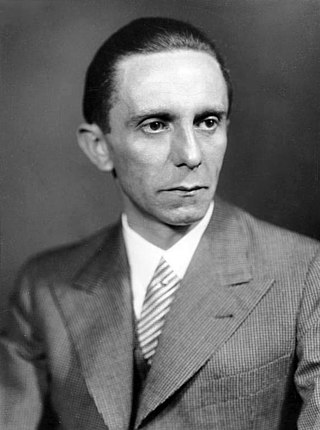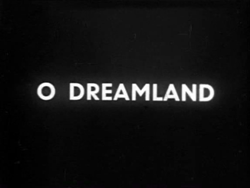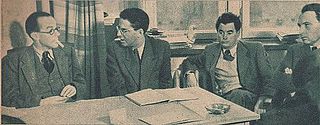
A documentary film is a non-fictional motion picture intended to "document reality, primarily for instruction, education or maintaining a historical record". The American author and media analyst Bill Nichols has characterized the documentary in terms of "a filmmaking practice, a cinematic tradition, and mode of audience reception [that remains] a practice without clear boundaries".

John Grierson was a Scottish documentary maker, often considered the father of British and Canadian documentary film. In 1926, Grierson coined the term "documentary" in a review of Robert J. Flaherty's Moana. In 1939, Grierson established the all-time Canadian film institutional production and distribution company The National Film Board of Canada controlled by the Government of Canada.

Paul Joseph Goebbels was a German Nazi politician and philologist who was the Gauleiter of Berlin, chief propagandist for the Nazi Party, and then Reich Minister of Propaganda from 1933 to 1945. He was one of Adolf Hitler's closest and most devoted followers, known for his skills in public speaking and his deeply virulent antisemitism which was evident in his publicly voiced views. He advocated progressively harsher discrimination, including the extermination of the Jews in the Holocaust.

A propaganda film is a film that involves some form of propaganda. Propaganda films spread and promote certain ideas that are usually religious, political, or cultural in nature. A propaganda film is made with the intent that the viewer will adopt the position promoted by the propagator and eventually take action towards making those ideas widely accepted. Propaganda films are popular mediums of propaganda due to their ability to easily reach a large audience in a short amount of time. They are also able to come in a variety of film types such as documentary, non-fiction, and newsreel, making it even easier to provide subjective content that may be deliberately misleading.

Frank Humphrey Sinkler Jennings was an English documentary filmmaker and one of the founders of the Mass Observation organisation. Jennings was described by film critic and director Lindsay Anderson in 1954 as "the only real poet that British cinema has yet produced".
John Louis Beddington (1893–1959) was a United Kingdom advertising executive, best known for his work as publicity director for Shell in the 1930s and as head of the Ministry of Information Films Division during World War II.
The GPO Film Unit was a subdivision of the UK General Post Office. The unit was established in 1933, taking on responsibilities of the Empire Marketing Board Film Unit. Headed by John Grierson, it was set up to produce sponsored documentary films mainly related to the activities of the GPO.
Arnold Roger Manvell was the first director of the British Film Academy (1947–1959) and author of many books on films and film-making. He wrote many books on Nazi Germany, including biographies of Adolf Hitler, Rudolf Hess, Heinrich Himmler, Joseph Goebbels and Hermann Göring.
Sir Arthur Hallam Rice Elton, 10th Baronet was a pioneer of the British documentary film industry.

O Dreamland is a 1953 documentary short film by British film director Lindsay Anderson.
Ian Dalrymple was a British screenwriter, film director, film editor and film producer.

A Diary for Timothy is a 1945 British documentary film directed by Humphrey Jennings. It was produced by Basil Wright for the Crown Film Unit. The narration, spoken by Michael Redgrave, was written by Jennings and E. M. Forster and is an account of the progress of the war during the first six months of the life of a baby named Timothy.

Basil Charles Wright was an English documentary filmmaker, film historian, film critic and teacher.
Edgar Anstey, was a leading British documentary filmmaker.

London Can Take It! is a 1940 short British propaganda film directed by by Humphrey Jennings and Harry Watt and narrated by US journalist and war correspondent Quentin Reynolds. It was produced by the GPO Film Unit for the British Ministry of Information and distributed throughout the United States by Warner Bros. The film shows the effects of eighteen hours of the German blitz on London and its people.
Documentary mode is a conceptual scheme developed by American documentary theorist Bill Nichols that seeks to distinguish particular traits and conventions of various documentary film styles. Nichols identifies six different documentary 'modes' in his schema: poetic, expository, observational, participatory, reflexive, and performative. While Nichols' discussion of modes does progress chronologically with the order of their appearance in practice, documentary film often returns to themes and devices from previous modes. Therefore, it is inaccurate to think of modes as historical punctuation marks in an evolution towards an ultimate accepted documentary style. Also, modes are not mutually exclusive. There is often significant overlapping between modalities within individual documentary features. As Nichols points out, "the characteristics of a given mode function as a dominant in a given film…but they do not dictate or determine every aspect of its organization."

The Silent Village is a 1943 British propaganda short film in the form of a drama documentary, made by the Crown Film Unit and directed by Humphrey Jennings. The film was named one of the top 5 documentaries of 1943 by the National Board of Review. It was inspired by the Lidice massacre in Czech Republic in June 1942.

Words for Battle is a British propaganda film produced by the Ministry of Information's Crown Film Unit in 1941. It was written and directed by Humphrey Jennings, and features seven sequences, each containing images of rural and urban Britain at war overlaid with audio commentary by Laurence Olivier, reciting passages from different English literary works and speeches.

Documentary News Letter was a magazine about documentary film founded by filmmaker John Grierson. The publication was developed as the wartime successor to World Film News, which ceased publication in 1938, and sought to promote a "documentary approach to everyday living." It published its first edition in January 1940, with an editorial board that consisted of Grierson, Paul Rotha, Basil Wright, Arthur Elton and Thomas Baird.
Stewart McAllister was a British documentary film editor who collaborated closely with Humphrey Jennings during the Second World War to produce films for the Crown Film Unit of the Ministry of Information. His contributions towards these films was largely neglected until Dai Vaughan's biography of him, Portrait of an Invisible Man, was published in 1983.












